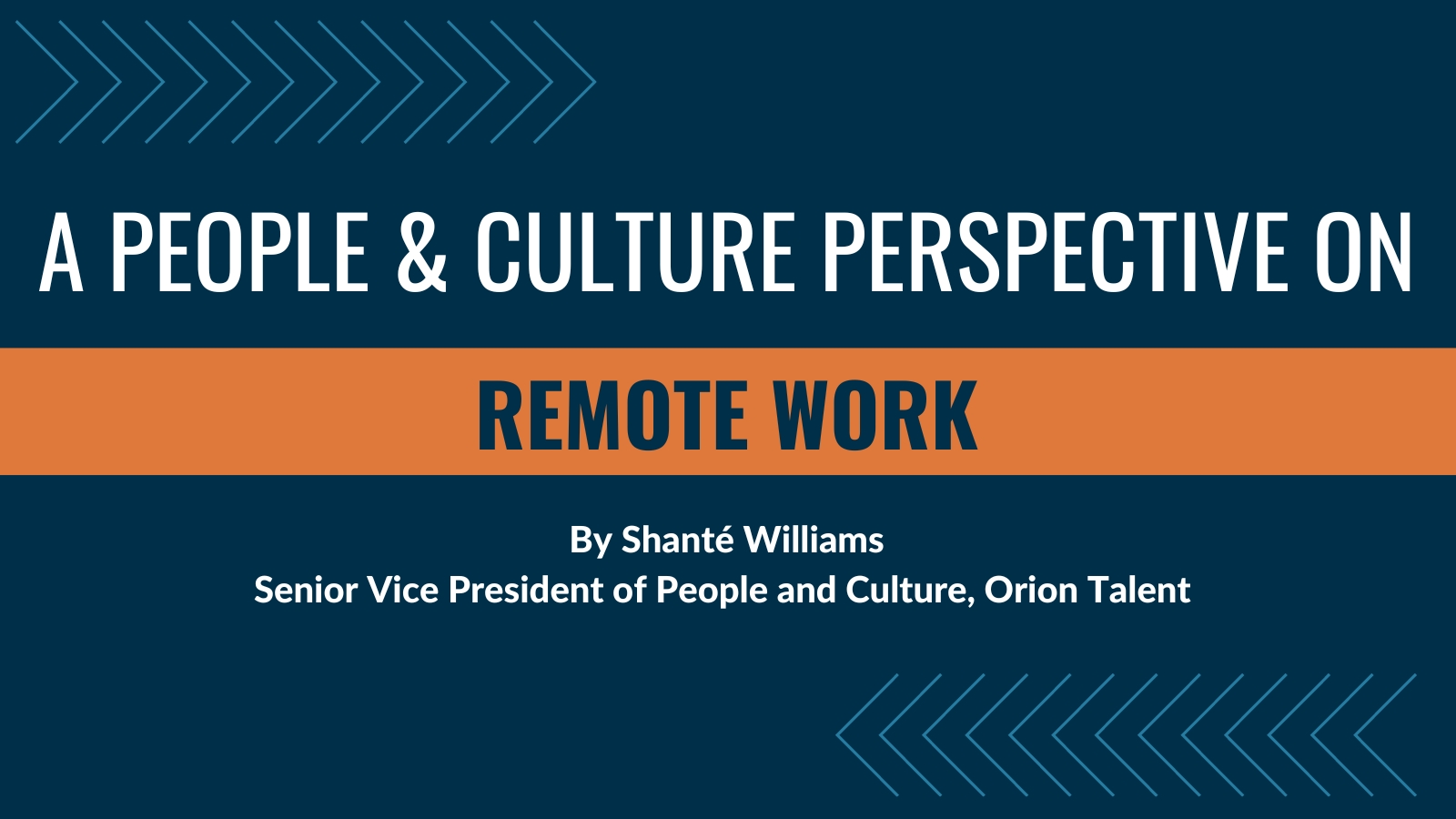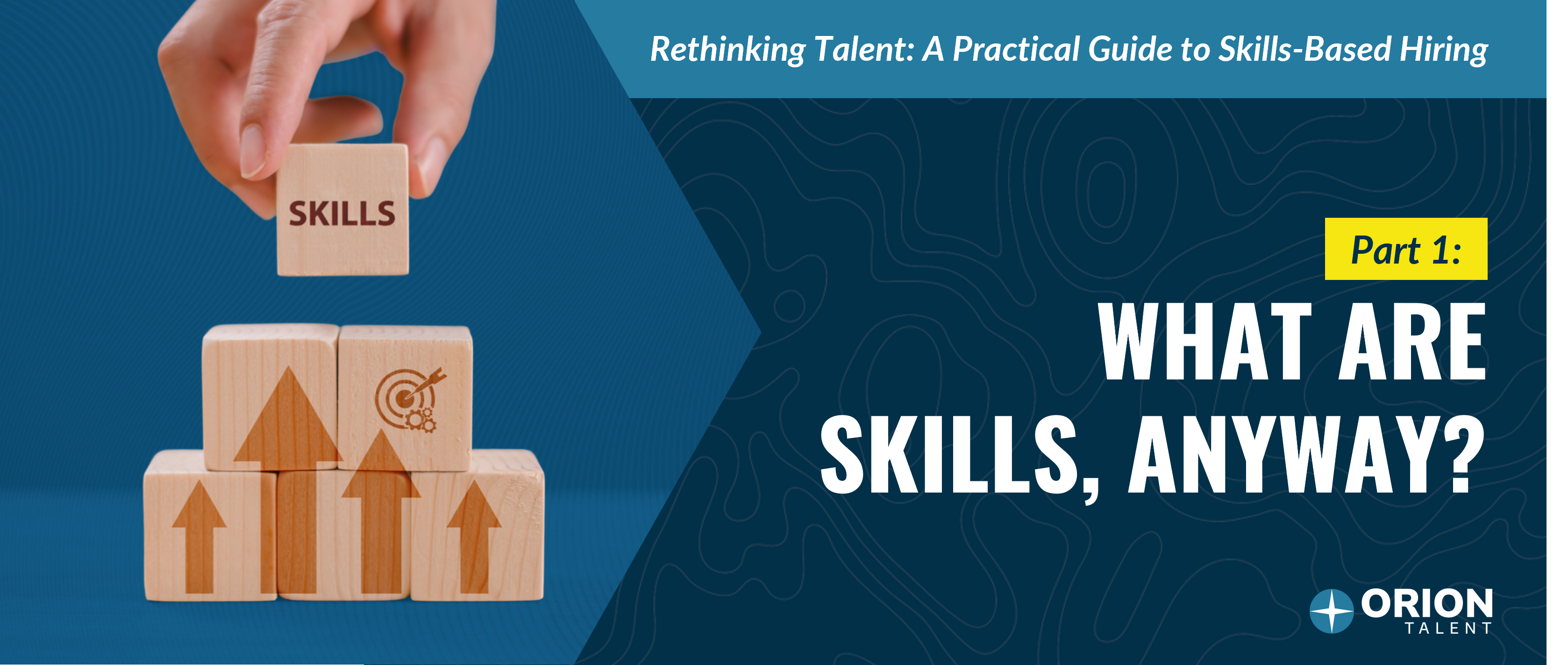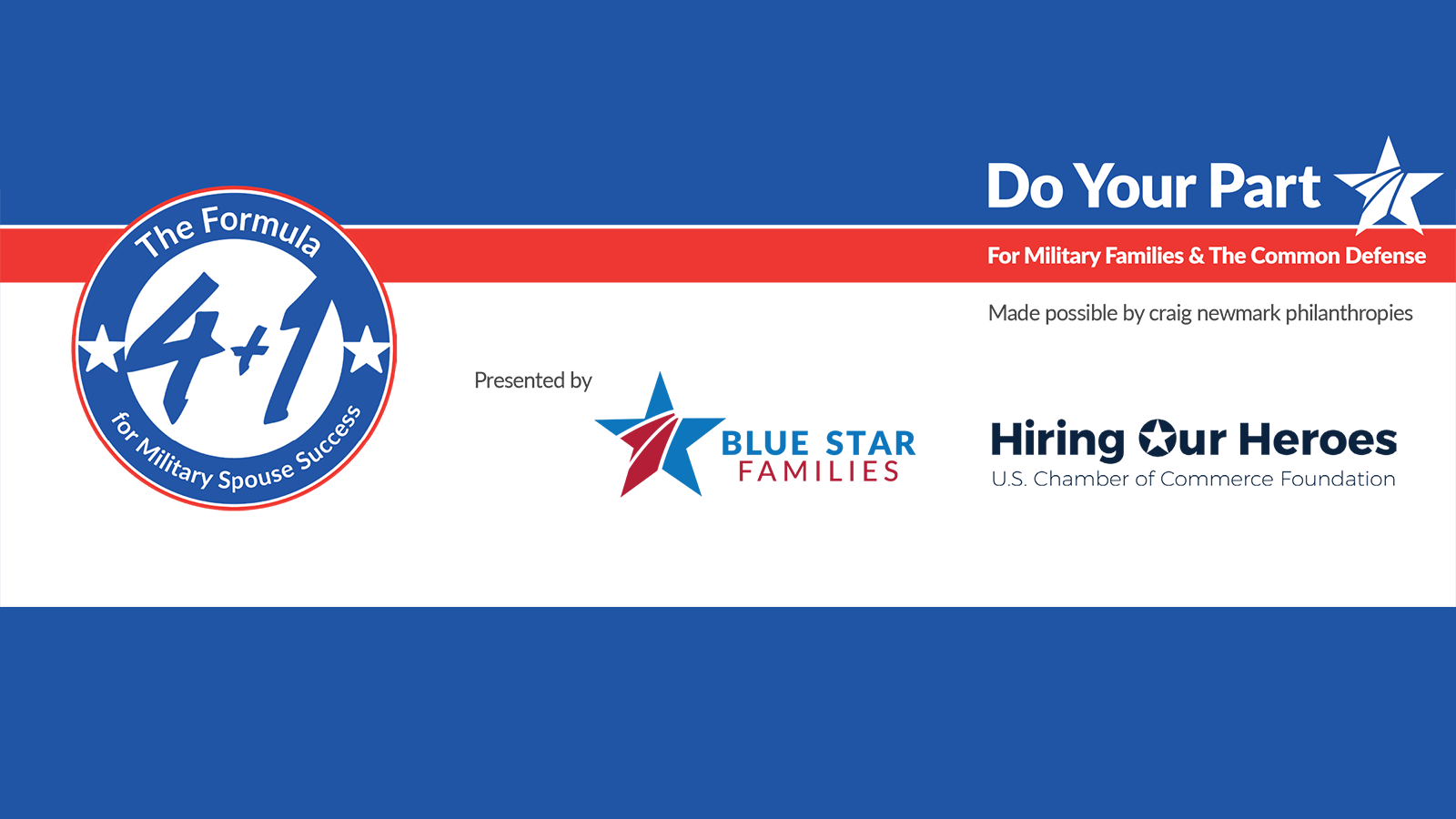
Orion Talent’s Transition to a Remote Workforce and Lessons Learned Along the Way
Our outlook on remote work has shifted wildly since 2020 and we find the workplace forever changed. According to a study by Owl Labs and Global Workplace Analytics, 74% of employees feel happier when they work remotely. Ninety-seven percent (97%) of those surveyed by Buffer recommend remote work to others; the same percentage would prefer to continue working remotely for the rest of their careers. In fact, 48% of U.S. workers surveyed by the Society for Human Resource Management said they will “definitely” seek a remote position for their next job. Remote workers are productive, healthier, and generally enjoy a better work/life balance.
Despite recent return-to-the-office initiatives, remote work is here to stay. Boston Consulting Group warns of “zombie” office buildings with vacancy rates and utilization under 50%, and many buildings across the U.S. are already experiencing this. Businesses that force a return-to-office policy will hurt their talent retention and recruitment efforts. I agree with Ellevest co-founder CEO Sallie Krawchck when she says flexibility is the new currency; Pre-pandemic work arrangements didn’t work for everyone and companies that try to recreate that workplace will be left behind when it comes to attracting and retaining the best talent.
Transforming from a Brick-and-Mortar to Remote Workforce
If you were to step into an Orion Talent office in 2019, it would be a bustling place. At this moment in time, only two of our employees worked remotely (out of several hundred). Meetings occurred in person, watercooler chit-chat was an everyday thing, and popping in and out of offices was the norm. I miss that personally and think that needs to be accounted for in a virtual world. We must find ways to adapt to these losses in office culture.
 Like many organizations, Covid-19 forced us to pivot and find a new workable solution. Our Orion microcosm is a pretty accurate representation of larger workforce trends. Before the Pandemic, only 6% of workers worked entirely from home and ¾ had never worked from home. In May 2020, 1/3 of employees worked from home. The numbers were higher for office-based and professional occupations with ¾ of workers shifting to remote work during the Pandemic. Today, our workforce is nearly entirely remote. While we still have brick-and-mortar offices in North Carolina, Virginia, and California, our employees are scattered across the United States. Those who live near an Orion office location have created their own hybrid work schedule, popping in and out of our brick-and-mortar locations when they find it stimulating. It’s working well for us!
Like many organizations, Covid-19 forced us to pivot and find a new workable solution. Our Orion microcosm is a pretty accurate representation of larger workforce trends. Before the Pandemic, only 6% of workers worked entirely from home and ¾ had never worked from home. In May 2020, 1/3 of employees worked from home. The numbers were higher for office-based and professional occupations with ¾ of workers shifting to remote work during the Pandemic. Today, our workforce is nearly entirely remote. While we still have brick-and-mortar offices in North Carolina, Virginia, and California, our employees are scattered across the United States. Those who live near an Orion office location have created their own hybrid work schedule, popping in and out of our brick-and-mortar locations when they find it stimulating. It’s working well for us!
Remote work removes borders. Once we were no longer restricted to geographic locations, our talent pool increased significantly. This has done much to increase the diversity of our employee makeup and also allowed us to better support our military spouses by providing mobile career opportunities that move with them.
What are Some of the Challenges of a Remote Workplace?
I love the freedom remote work brings to my life. Yet, it’s certainly not without challenges. If you’re like many workers, it’s difficult to unplug from work when your home and office are one and the same. Other struggles remote workers may experience include loneliness, communication and collaboration difficulties, distractions at home, being in different time zones from their teammates, staying motivated, and taking a vacation or sick time.
Organizational Challenges in a Remote Environment
As business leaders, we’ve experienced our share of growing pains when it came to transitioning to a remote workforce. Here are a few of the challenges we’ve faced:
Human Resources
Our onboarding sessions were previously face-to-face. Once we went virtual, we had to reimagine how to create an equally effective onboarding experience virtually and while it had its challenges, there have been even more successes. For one, our onboarding system went paperless. Hooray for the environment! Virtual materials are easier to update more frequently; I love that our new employee materials and employee handbook have never been more current. It’s so simple to publish and share an update! Creating a seamless remote onboarding process helps new hires thrive, makes them feel welcome, and provides them with all the information and assistance they need to be successful from Day 1.
Recently, we rebranded our Human Resources department to People and Culture, which better reflects our team’s purpose, scope, and vision and the work we are doing. Not having an in-office HR department to turn to with questions can be a challenge, so we’ve become more proactive in our consultation and guidance around everything people related at Orion. HR has become more human, accessible, and integrated into every department and this has worked well for us.
We’ve been challenged to find new ways to leverage our Human Resource Information System (HRIS). Since we’re no longer in the office and employees can’t just pop in with a question, we’ve moved some of these engagement activities into the electronic world. At Orion, this includes important announcements, recognizing anniversaries, milestones, birthdays, or special moments, and even building upon our DEI journey with interactive games such as DEI trivia. We’re literally using our HRIS as our employee intranet, allowing for an open flow of information.
Keeping Employees Engaged
Employee engagement is critical to your business strategy. Engaged employees are not only happier, but they also perform better. How exactly should leaders promote employee engagement in a remote work environment? How do we properly reward employees who work remotely? And how do we recognize them for hitting their goals/ completing projects?
At Orion, we implemented a Kudos system where employees recognized their co-workers for acts of helpfulness or a job well done (tied into how they exemplify our company’s Core Values). Each month, we hosted a company-wide celebratory meeting where nominations were drawn, public shout-outs read aloud, and winners provided a gift card of their choice. We’ve built on this practice this year, making all Kudos visible to all team members on our HRIS and leading to broader recognition. It’s like a virtual recognition wall, and employee recognition happens daily. We still do drawings every month since our team seems to like this. The integration with our HRIS has made it easier than ever to recognize employee milestones too. There’s even an employee swag store- managers can recognize their direct reports for a milestone or job well done. I think it’s been a success. In this remote environment, we are continuing to find innovative ways to keep our employees engaged. This is an ongoing work in progress in our new normal.
In the end, I still believe that employee engagement hinges on a manager’s behavior, so part of our employee engagement strategy consists of ongoing manager training. We’re always learning and growing.
Communication
Communication can be tricky in the best of times; Throw in language barriers, time zones, or the fact that emotion and meaning can be more difficult to convey in text, and you’ve got yourself a situation. It is vital to make sure your communication is clear and effective. Sometimes, the way you intend a message is not how it’s received or understood by the reader.
Our management team had to come together and align on “communication norms,” laying out the framework for what exactly communication should look like across our workforce. How should we best respond to various situations (urgent vs. non-urgent)? What situations require a phone call, and for which would a Teams Message or email work fine? What is the expected response time for our employees, and for ourselves? How can we implement dark times (unavailability) to respect a healthy work/life balance? In addition, we decided it was important for employees to be on camera during meetings.
We’ve experimented with a variety of platforms to make connections instantaneous and reliable. Microsoft Teams works well for us. We explored new ways to track tasks and productivity, build collaborative opportunities, and effectively present uninhibited by geography. To succeed, we need to be intentional in how we engage with our virtual workers. This is an area where we will continue to grow, learn, and try new things.
Retention
Early in the Pandemic, I read an article about how employees hired during the Pandemic felt more disconnected. Remote workers were susceptible to leaving within the first year. I think that’s not so much the case today. Employees are seeking out remote work options because they’re a better fit for their lifestyle. I believe our remote-first culture is one of the things that draws talent to Orion. 74% of employees say that remote work options would make them less likely to leave their company. I’d say that while it may not be for everyone, remote work options done right will improve your retention rate.
Security Concerns
Remote workers may become victims of email scams and the multiple layers of cyber protection in your office may not be as simple in a home environment. There’s a risk that sensitive company data could be accessed through unsecured Wi-Fi networks. How does a remote workforce combat cyber threats? Our IT Team works diligently to protect confidential data, combat phishing attempts, and provide VPN and other internet controls to keep both employee and company data secure. This is an area that needs to be constantly updated as the challenges are ever-changing.
What are Some Remote Work Best Practices?
Across our organization, retention remains strong. Long-time brick-and-mortar employers have successfully made the.jpg) transition to remote work (even the biggest nay-sayers among the bunch) and our team continues to add, onboard, train, and work alongside remote talent across North America. Our workforce has become so much more diverse. We’ve grown from a predominantly male organization to one where females make up 64% of our talent. Our workforce is 33% ethnically diverse and growing. We’re able to support traditionally marginalized workers, like military spouses, for whom remote work provides financial security despite uncertainty.
transition to remote work (even the biggest nay-sayers among the bunch) and our team continues to add, onboard, train, and work alongside remote talent across North America. Our workforce has become so much more diverse. We’ve grown from a predominantly male organization to one where females make up 64% of our talent. Our workforce is 33% ethnically diverse and growing. We’re able to support traditionally marginalized workers, like military spouses, for whom remote work provides financial security despite uncertainty.
Here are some practices we’ve implemented to forge a connection with our remote workforce:
Get to Know Each Other
Organize team meetups to build a social bonds- it’s so nice to put a name to a face in person. Our leadership teams meet multiple times annually to bond, strategize, and build camaraderie. The energy is palatable. Last year, we got together for volunteer service alongside the Oscar Mike Foundation, a non-profit that keeps injured veterans on the move through adaptive sports. It was an incredible and memorable experience, and I was so thankful for this team-building opportunity.
Another way to build connections is through creating workgroups and ERGs. Our Leadership & Employee Engagement Awareness and Career Development Work Groups have been well-received and our Employee Resource Groups (ERGs) encourage employees across all departments to meet virtually once monthly to build bridges of connection. I’m particularly passionate about our Women in Business and Veterans & Milspouse ERGs. They’re amazing ways to build community and connection with co-workers you might not otherwise encounter. You can learn more about our ERG Journey in this free webinar.
Be Responsive and Reliable
When team members are responsive and tasks are completed on time, trust and morale tend to remain high. This is the remote equivalent of knowing people are there for you when you need them.
Promote Transparency
Promote transparency at every level and demonstrate the benefits to team members. In a remote work environment, transparency ensures that your employees feel connected and like they are a valued part of the team. Each quarter, we hold a company-wide town hall and discuss not only company goals but how things have been going across the organization. Good, bad, or ugly. It’s so important to communicate your organization’s goals, policies, and challenges with honesty. Leave no room for speculation or gossip.
Get the Right Collaboration Tools
Be strategic in your choice of collaboration tools and experiment until you find the ones that work best for you and your organization. It’s okay to change course. I recommend tools that are intuitive to use, allow face-to-face calls, promote collaborative work and accountability, and integrate with your existing technology.
Create Shared Goals
One of our Core Values at Orion Talent is In It Together- We are one team. When people share goals, they have an invested interest in working together and covering each other’s backs. We look for ways to build a common connection and mission. It’s even more important to set clear goals and priorities in a remote environment, where it’s easier to misunderstand meaning. Be clear about the priority level of each task. Most importantly, be sure to celebrate the wins! When your team reaches its goals, when your employee is successful and achieves a milestone, celebrate! This is more important than ever when some of that office camaraderie is lost. You can’t pat them on the back or celebrate over the water cooler. So celebrate virtually, and be generous with your praise!
Keeping employees engaged and motivated can be more challenging in a remote environment, but it’s achievable with goal setting, frequent motivation, and celebration. For more ideas, be sure to check out these strategies for engaging and motivating early career talent.
Avoid Micromanagement
As leaders, it’s important to check in with team members and schedule time for 1-on-1 meetings. But be careful to avoid micromanagement as it can reduce employee incentive and lead to resentment. The amount of flexibility and freedom you offer your workforce depends on many factors. Just remember that employees tend to stay where they feel valued and trusted.
Keep Mental Health Top of Mind
The U.S. Surgeon General recently warned about an epidemic of loneliness and isolation in the United States. Even before Covid-19, 1 in 2 American adults reported feeling lonely. This impacts not only physical health but social connectivity across all aspects of society. A remote workplace didn’t cause loneliness, but loneliness may occur due to a lack of face-to-face interaction and your employees may be struggling with this. Not only is it dangerous to one’s mental health, but lonely employees are less productive and more likely to quit. As leaders, our employees’ mental health must remain top of mind. As businesses, we must provide easy access to mental health care and resources.
Separating work and private life and finding a healthy work-life balance is vital. Pay attention to verbal and non-verbal cues, and ask your employees how they are truly doing. Owl Labs offers some great advice about how to avoid loneliness while working remotely.
Lead by Example
Show your team members that you’re trustworthy and willing to trust them too. Cultivate an atmosphere of support and appreciation. Get to know one another; ask about their extracurricular activities and the people important to them. Meet your deadlines. Take time off for vacation, or if you are unwell. The list goes on. Treat your team as you’d want to be treated.
Concluding Thoughts
Workplace trends may come and go, but I don’t see remote and hybrid work going anywhere anytime soon. The better we understand this phenomenon, the more successful we can be—both for our employees and our business goals.
Recruitment Process Outsourcing (RPO) is one solution that helps companies improve their culture, increase retention, and meet their business goals. Be sure to check out Orion Talent’s (RPO) Services or reach out to us with any questions. We’d love to hear your perspective and experiences on remote workforce trends and what’s worked well for your organization.
Guest Writer Bio:
 Shanté Williams, Senior Vice President of People and Culture at Orion Talent, earned a BA in English and Psychology from the University of Southern California and a master’s degree in organizational psychology from Benedictine University. Her rich Human Resources background includes leading HR teams in various industries in both private and public organizations, most recently with the Greater Chicago Food Depository, Samuel, Son & Co, and BakerCorp “A United Rentals Company.”
Shanté Williams, Senior Vice President of People and Culture at Orion Talent, earned a BA in English and Psychology from the University of Southern California and a master’s degree in organizational psychology from Benedictine University. Her rich Human Resources background includes leading HR teams in various industries in both private and public organizations, most recently with the Greater Chicago Food Depository, Samuel, Son & Co, and BakerCorp “A United Rentals Company.”
Shanté is proud of Orion’s commitment to diversity, equity, and inclusion and is dedicated to creating a work environment where each and every employee is welcome, respected, and can bring their authentic self. She believes that accountability, transparency, agility, and a company’s approach to hiring, developing, and advancing its employees are critical for creating a stronger, more inclusive future. You can connect with her on LinkedIn.
Archives
- December 2025
- November 2025
- October 2025
- September 2025
- August 2025
- July 2025
- June 2025
- May 2025
- April 2025
- March 2025
- February 2025
- October 2024
- May 2024
- March 2024
- February 2024
- January 2024
- December 2023
- November 2023
- October 2023
- September 2023
- August 2023
- July 2023
- June 2023
- May 2023
- April 2023
- March 2023
- February 2023
- January 2023
- December 2022
- November 2022
- October 2022
- September 2022
- August 2022
- July 2022
- June 2022
- May 2022
- April 2022
- March 2022
- February 2022
- January 2022
- December 2021
- November 2021
- October 2021
- September 2021
- August 2021
- July 2021
- June 2021
- May 2021
- April 2021
- March 2021
- February 2021
- January 2021
- December 2020
- November 2020
- October 2020
- September 2020
- August 2020
- July 2020
- June 2020
- May 2020
- April 2020
- March 2020
- February 2020
- January 2020
- December 2019
- November 2019
- October 2019
- September 2019
- August 2019
- July 2019
- June 2019
- May 2019
- April 2019
- March 2019
- February 2019
- January 2019
- December 2018
- November 2018
- October 2018
- September 2018
- August 2018
- July 2018
- June 2018
- May 2018
- April 2018
- March 2018
- February 2018
- January 2018
- December 2017
- November 2017
- October 2017
- September 2017
- August 2017
- July 2017
- June 2017
- May 2017
- March 2017
- February 2017
- January 2017
 RSS Feed
RSS Feed




















